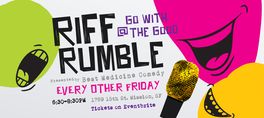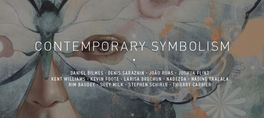Sasami with Mood Killer
Two Sasami's exist in harmony. First is Sasami Ashworth, the conservatory-trained classical French horn player, producer, and composer--an artist with a studious approach to craft. And then there is all-caps SASAMI, the fearless performer and protagonist of her three increasingly audacious albums. For Blood On the Silver Screen, these two sides fused for her most epic and realized music to date: the all-out Sasami pop record. "This album is all about learning and respecting the craft of pop songwriting, about relenting to illogical passion, obsession, and guiltless pleasure," Sasami says. "It's about leaning into the chaos of romance and sweeping devotion--romanticism to the point of self-destruction."
After establishing herself with the poised melancholia of her eponymous 2019 debut, Sasami embraced volume and control on 2022's Squeeze, but her goal on Blood On the Silver Screen was to speak her truth with conviction by singing. Working with producers Jenn Decilveo and Rostam, with Sasami as sole writer, each Blood On the Silver Screen track viscerally captures a different thread of love, sex, power, and embodiment. "Pop music is like fuel," Sasami says. "It's just invigorating."
She came to that fact while training to tour Squeeze--shows that required her to run around with her Mockingbird guitar, mosh, leap off amps--at the gym. Sasami found herself fascinated by the high-octane music that sustains physical activity. "The gym became this place where I would exercise and be studying the music," Sasami says. Eschewing today's pop zeitgeist, Sasami gravitated towards late aughts and 2010s pop a la Britney Spears' Femme Fatale and Lady Gaga's Born This Way, plus Kelly Clarkson, Katy Perry, and Sia. She was influenced by modern country storytelling, mixing vulnerability with humor, and the mood board also included Prince, Japanese city pop, and the stadium-sized, denim-clad iconography of Bruce Springsteen.
"I wanted to go all out with this album," Sasami says. "I wanted to, in my tenderness and emotionality, have the bravery to undertake something as epic as making a pop record about love. I hope it makes people feel empowered and embodied, too. It's important to not box yourself in."
~~~
SASAMI (Sasami Ashworth) will release her second studio album, Squeeze, on February 25, 2022 on Domino Records. Squeeze hammers home a sentiment of "anti-toxic positivity" and showcases her vicious honesty and brutally uncompromising vision, partially inspired by the Japanese yokai folk spirit called Nure-onna (translation: wet woman), a vampiric deity that has the head of a woman and the body of a snake.
On Squeeze, SASAMI explores her wide spectrum of moods--from raging at systemic violence to wrestling for control in her personal relationships. Throughout, the singer-songwriter and producer surveys the raw aggression of nu-metal, tender plainspokeness of country-pop and folk rock, and dramatic romanticism of classical music.
Based in Los Angeles, SASAMI is a descendent of the Zainichi people on her mother's side, a diaspora of ethnic Koreans who lived in Japan during Japan's occupation of Korea from 1910 to 1945. Though some Zainichi moved voluntarily and others were forcibly kidnapped, these people and their progeny continue to experience systemic discrimination and oppression in Japan to this day. While conducting a deep dive into her family's mixed Korean and Japanese history and culture, SASAMI stumbled upon stories of Nure-onna and was immediately drawn to the water creature's multiplicitous nature. According to legend, the deity is feminine and noble, yet powerful and vicious enough to brutally destroy victims with her blood sucking tongue.
The fluidity of the Nure-onna can be felt in how Squeeze naturally flows through musical influences--from System of a Down to Sheryl Crow and Fleetwood Mac, to even Bach and Mahler. A classically-trained composer, SASAMI constructed the LP in the form of an opera or orchestral work that has different "movements" that take the listener on an emotional journey. Compared to the introspective indie rock of SASAMI's 2019 self-titled debut album, Squeeze is a full-throttled expansion.
The dark, fantastical elements of the Nure-onna legend feeds into SASAMI's use of heavy rock elements throughout Squeeze. She hopes that listeners will identify with this new sinister, intense sound and use it as a soundtrack for processing their "anger, frustration, desperation, and more violent, aggressive emotions." Her ultimate desire is for marginalized folks, including femmes, BIPOC, and queer people, to listen to Squeeze and find catharsis from the oppression and violence that they experience.
In reclamatory fashion, SASAMI assumes the form of Nure-onna on the record's Japanese horror film-inspired cover art, designed by Andrew Thomas Huang (Björk, FKA twigs) and Rin Kim. She chose to pair this Japanese folklore-referencing image with Squeeze written in Korean calligraphy by Myung-Ja Ashworth, SASAMI's mom, as another act of Zainichi empowerment. On the back, the title is written in Japanese script.
show less
Two Sasami's exist in harmony. First is Sasami Ashworth, the conservatory-trained classical French horn player, producer, and composer--an artist with a studious approach to craft. And then there is all-caps SASAMI, the fearless performer and protagonist of her three increasingly audacious albums. For Blood On the Silver Screen, these two sides fused for her most epic and realized music to date: the all-out Sasami pop record. "This album is all about learning and respecting the craft of pop songwriting, about relenting to illogical passion, obsession, and guiltless pleasure," Sasami says. "It's about leaning into the chaos of romance and sweeping devotion--romanticism to the point of self-destruction."
After establishing herself with the poised melancholia of her eponymous 2019 debut, Sasami embraced volume and control on 2022's Squeeze, but her goal on Blood On the Silver Screen was to speak her truth with conviction by singing. Working with producers Jenn Decilveo and Rostam, with Sasami as sole writer, each Blood On the Silver Screen track viscerally captures a different thread of love, sex, power, and embodiment. "Pop music is like fuel," Sasami says. "It's just invigorating."
She came to that fact while training to tour Squeeze--shows that required her to run around with her Mockingbird guitar, mosh, leap off amps--at the gym. Sasami found herself fascinated by the high-octane music that sustains physical activity. "The gym became this place where I would exercise and be studying the music," Sasami says. Eschewing today's pop zeitgeist, Sasami gravitated towards late aughts and 2010s pop a la Britney Spears' Femme Fatale and Lady Gaga's Born This Way, plus Kelly Clarkson, Katy Perry, and Sia. She was influenced by modern country storytelling, mixing vulnerability with humor, and the mood board also included Prince, Japanese city pop, and the stadium-sized, denim-clad iconography of Bruce Springsteen.
"I wanted to go all out with this album," Sasami says. "I wanted to, in my tenderness and emotionality, have the bravery to undertake something as epic as making a pop record about love. I hope it makes people feel empowered and embodied, too. It's important to not box yourself in."
~~~
SASAMI (Sasami Ashworth) will release her second studio album, Squeeze, on February 25, 2022 on Domino Records. Squeeze hammers home a sentiment of "anti-toxic positivity" and showcases her vicious honesty and brutally uncompromising vision, partially inspired by the Japanese yokai folk spirit called Nure-onna (translation: wet woman), a vampiric deity that has the head of a woman and the body of a snake.
On Squeeze, SASAMI explores her wide spectrum of moods--from raging at systemic violence to wrestling for control in her personal relationships. Throughout, the singer-songwriter and producer surveys the raw aggression of nu-metal, tender plainspokeness of country-pop and folk rock, and dramatic romanticism of classical music.
Based in Los Angeles, SASAMI is a descendent of the Zainichi people on her mother's side, a diaspora of ethnic Koreans who lived in Japan during Japan's occupation of Korea from 1910 to 1945. Though some Zainichi moved voluntarily and others were forcibly kidnapped, these people and their progeny continue to experience systemic discrimination and oppression in Japan to this day. While conducting a deep dive into her family's mixed Korean and Japanese history and culture, SASAMI stumbled upon stories of Nure-onna and was immediately drawn to the water creature's multiplicitous nature. According to legend, the deity is feminine and noble, yet powerful and vicious enough to brutally destroy victims with her blood sucking tongue.
The fluidity of the Nure-onna can be felt in how Squeeze naturally flows through musical influences--from System of a Down to Sheryl Crow and Fleetwood Mac, to even Bach and Mahler. A classically-trained composer, SASAMI constructed the LP in the form of an opera or orchestral work that has different "movements" that take the listener on an emotional journey. Compared to the introspective indie rock of SASAMI's 2019 self-titled debut album, Squeeze is a full-throttled expansion.
The dark, fantastical elements of the Nure-onna legend feeds into SASAMI's use of heavy rock elements throughout Squeeze. She hopes that listeners will identify with this new sinister, intense sound and use it as a soundtrack for processing their "anger, frustration, desperation, and more violent, aggressive emotions." Her ultimate desire is for marginalized folks, including femmes, BIPOC, and queer people, to listen to Squeeze and find catharsis from the oppression and violence that they experience.
In reclamatory fashion, SASAMI assumes the form of Nure-onna on the record's Japanese horror film-inspired cover art, designed by Andrew Thomas Huang (Björk, FKA twigs) and Rin Kim. She chose to pair this Japanese folklore-referencing image with Squeeze written in Korean calligraphy by Myung-Ja Ashworth, SASAMI's mom, as another act of Zainichi empowerment. On the back, the title is written in Japanese script.
Sasami with Mood Killer
Two Sasami's exist in harmony. First is Sasami Ashworth, the conservatory-trained classical French horn player, producer, and composer--an artist with a studious approach to craft. And then there is all-caps SASAMI, the fearless performer and protagonist of her three increasingly audacious albums. For Blood On the Silver Screen, these two sides fused for her most epic and realized music to date: the all-out Sasami pop record. "This album is all about learning and respecting the craft of pop songwriting, about relenting to illogical passion, obsession, and guiltless pleasure," Sasami says. "It's about leaning into the chaos of romance and sweeping devotion--romanticism to the point of self-destruction."
After establishing herself with the poised melancholia of her eponymous 2019 debut, Sasami embraced volume and control on 2022's Squeeze, but her goal on Blood On the Silver Screen was to speak her truth with conviction by singing. Working with producers Jenn Decilveo and Rostam, with Sasami as sole writer, each Blood On the Silver Screen track viscerally captures a different thread of love, sex, power, and embodiment. "Pop music is like fuel," Sasami says. "It's just invigorating."
She came to that fact while training to tour Squeeze--shows that required her to run around with her Mockingbird guitar, mosh, leap off amps--at the gym. Sasami found herself fascinated by the high-octane music that sustains physical activity. "The gym became this place where I would exercise and be studying the music," Sasami says. Eschewing today's pop zeitgeist, Sasami gravitated towards late aughts and 2010s pop a la Britney Spears' Femme Fatale and Lady Gaga's Born This Way, plus Kelly Clarkson, Katy Perry, and Sia. She was influenced by modern country storytelling, mixing vulnerability with humor, and the mood board also included Prince, Japanese city pop, and the stadium-sized, denim-clad iconography of Bruce Springsteen.
"I wanted to go all out with this album," Sasami says. "I wanted to, in my tenderness and emotionality, have the bravery to undertake something as epic as making a pop record about love. I hope it makes people feel empowered and embodied, too. It's important to not box yourself in."
~~~
SASAMI (Sasami Ashworth) will release her second studio album, Squeeze, on February 25, 2022 on Domino Records. Squeeze hammers home a sentiment of "anti-toxic positivity" and showcases her vicious honesty and brutally uncompromising vision, partially inspired by the Japanese yokai folk spirit called Nure-onna (translation: wet woman), a vampiric deity that has the head of a woman and the body of a snake.
On Squeeze, SASAMI explores her wide spectrum of moods--from raging at systemic violence to wrestling for control in her personal relationships. Throughout, the singer-songwriter and producer surveys the raw aggression of nu-metal, tender plainspokeness of country-pop and folk rock, and dramatic romanticism of classical music.
Based in Los Angeles, SASAMI is a descendent of the Zainichi people on her mother's side, a diaspora of ethnic Koreans who lived in Japan during Japan's occupation of Korea from 1910 to 1945. Though some Zainichi moved voluntarily and others were forcibly kidnapped, these people and their progeny continue to experience systemic discrimination and oppression in Japan to this day. While conducting a deep dive into her family's mixed Korean and Japanese history and culture, SASAMI stumbled upon stories of Nure-onna and was immediately drawn to the water creature's multiplicitous nature. According to legend, the deity is feminine and noble, yet powerful and vicious enough to brutally destroy victims with her blood sucking tongue.
The fluidity of the Nure-onna can be felt in how Squeeze naturally flows through musical influences--from System of a Down to Sheryl Crow and Fleetwood Mac, to even Bach and Mahler. A classically-trained composer, SASAMI constructed the LP in the form of an opera or orchestral work that has different "movements" that take the listener on an emotional journey. Compared to the introspective indie rock of SASAMI's 2019 self-titled debut album, Squeeze is a full-throttled expansion.
The dark, fantastical elements of the Nure-onna legend feeds into SASAMI's use of heavy rock elements throughout Squeeze. She hopes that listeners will identify with this new sinister, intense sound and use it as a soundtrack for processing their "anger, frustration, desperation, and more violent, aggressive emotions." Her ultimate desire is for marginalized folks, including femmes, BIPOC, and queer people, to listen to Squeeze and find catharsis from the oppression and violence that they experience.
In reclamatory fashion, SASAMI assumes the form of Nure-onna on the record's Japanese horror film-inspired cover art, designed by Andrew Thomas Huang (Björk, FKA twigs) and Rin Kim. She chose to pair this Japanese folklore-referencing image with Squeeze written in Korean calligraphy by Myung-Ja Ashworth, SASAMI's mom, as another act of Zainichi empowerment. On the back, the title is written in Japanese script.
read more
Two Sasami's exist in harmony. First is Sasami Ashworth, the conservatory-trained classical French horn player, producer, and composer--an artist with a studious approach to craft. And then there is all-caps SASAMI, the fearless performer and protagonist of her three increasingly audacious albums. For Blood On the Silver Screen, these two sides fused for her most epic and realized music to date: the all-out Sasami pop record. "This album is all about learning and respecting the craft of pop songwriting, about relenting to illogical passion, obsession, and guiltless pleasure," Sasami says. "It's about leaning into the chaos of romance and sweeping devotion--romanticism to the point of self-destruction."
After establishing herself with the poised melancholia of her eponymous 2019 debut, Sasami embraced volume and control on 2022's Squeeze, but her goal on Blood On the Silver Screen was to speak her truth with conviction by singing. Working with producers Jenn Decilveo and Rostam, with Sasami as sole writer, each Blood On the Silver Screen track viscerally captures a different thread of love, sex, power, and embodiment. "Pop music is like fuel," Sasami says. "It's just invigorating."
She came to that fact while training to tour Squeeze--shows that required her to run around with her Mockingbird guitar, mosh, leap off amps--at the gym. Sasami found herself fascinated by the high-octane music that sustains physical activity. "The gym became this place where I would exercise and be studying the music," Sasami says. Eschewing today's pop zeitgeist, Sasami gravitated towards late aughts and 2010s pop a la Britney Spears' Femme Fatale and Lady Gaga's Born This Way, plus Kelly Clarkson, Katy Perry, and Sia. She was influenced by modern country storytelling, mixing vulnerability with humor, and the mood board also included Prince, Japanese city pop, and the stadium-sized, denim-clad iconography of Bruce Springsteen.
"I wanted to go all out with this album," Sasami says. "I wanted to, in my tenderness and emotionality, have the bravery to undertake something as epic as making a pop record about love. I hope it makes people feel empowered and embodied, too. It's important to not box yourself in."
~~~
SASAMI (Sasami Ashworth) will release her second studio album, Squeeze, on February 25, 2022 on Domino Records. Squeeze hammers home a sentiment of "anti-toxic positivity" and showcases her vicious honesty and brutally uncompromising vision, partially inspired by the Japanese yokai folk spirit called Nure-onna (translation: wet woman), a vampiric deity that has the head of a woman and the body of a snake.
On Squeeze, SASAMI explores her wide spectrum of moods--from raging at systemic violence to wrestling for control in her personal relationships. Throughout, the singer-songwriter and producer surveys the raw aggression of nu-metal, tender plainspokeness of country-pop and folk rock, and dramatic romanticism of classical music.
Based in Los Angeles, SASAMI is a descendent of the Zainichi people on her mother's side, a diaspora of ethnic Koreans who lived in Japan during Japan's occupation of Korea from 1910 to 1945. Though some Zainichi moved voluntarily and others were forcibly kidnapped, these people and their progeny continue to experience systemic discrimination and oppression in Japan to this day. While conducting a deep dive into her family's mixed Korean and Japanese history and culture, SASAMI stumbled upon stories of Nure-onna and was immediately drawn to the water creature's multiplicitous nature. According to legend, the deity is feminine and noble, yet powerful and vicious enough to brutally destroy victims with her blood sucking tongue.
The fluidity of the Nure-onna can be felt in how Squeeze naturally flows through musical influences--from System of a Down to Sheryl Crow and Fleetwood Mac, to even Bach and Mahler. A classically-trained composer, SASAMI constructed the LP in the form of an opera or orchestral work that has different "movements" that take the listener on an emotional journey. Compared to the introspective indie rock of SASAMI's 2019 self-titled debut album, Squeeze is a full-throttled expansion.
The dark, fantastical elements of the Nure-onna legend feeds into SASAMI's use of heavy rock elements throughout Squeeze. She hopes that listeners will identify with this new sinister, intense sound and use it as a soundtrack for processing their "anger, frustration, desperation, and more violent, aggressive emotions." Her ultimate desire is for marginalized folks, including femmes, BIPOC, and queer people, to listen to Squeeze and find catharsis from the oppression and violence that they experience.
In reclamatory fashion, SASAMI assumes the form of Nure-onna on the record's Japanese horror film-inspired cover art, designed by Andrew Thomas Huang (Björk, FKA twigs) and Rin Kim. She chose to pair this Japanese folklore-referencing image with Squeeze written in Korean calligraphy by Myung-Ja Ashworth, SASAMI's mom, as another act of Zainichi empowerment. On the back, the title is written in Japanese script.
show less
Date/Times:
The Chapel
8 Upcoming Events
777 Valencia Street, San Francisco, CA 94110
The Best Events
Every Week in Your Inbox
From Our Sponsors
UPCOMING EVENTS
Great suggestion! We'll be in touch.
Event reviewed successfully.










